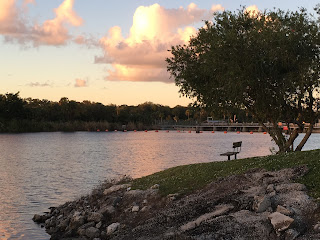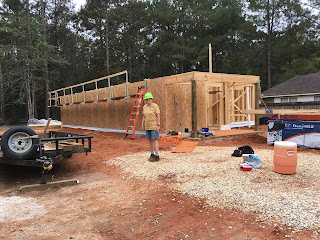Tuesday, December 5, 2017
It's a Lock!
Several campgrounds are vying for our Number One Campground Choice for 2017 so perhaps it's too early to mention the winning one that's a lock.
But then on the other hand, our latest campground is a lock, the St. Lucie Lock Recreation Area, a Corp of Engineers' facility built next to the St. Lucie Lock.
The lock is one of a series that enable boaters to sail the shortcut passage of the Intercoastal Waterway, the one that bisects the Florida peninsula from Stuart, FL on the Atlantic side to Fort Myers on the Gulf of Mexico.
Tim and I found this campground in 2016 when we were working at a nearby Habitat for Humanity construction site in Indiantown, FL. That first visit coincided with the passage of a very special outrigger, the Hōkūleʻa, through the lock. (Read here to learn more of that chance encounter.)
We knew then that we wanted to come back to Stuart and camp at this special place.
However, it wasn't easy to make a reservation on recreation.gov. Oh, logging into the website was not the problem; it was the waiting up until midnight six months prior to the dates we wanted in order to click Submit ahead of all the other aspirants who desired one of the nine campsites located at this sought-after campground that was hard.
Thanks to Tim's lightning-quick stroke, we landed on Site 5 for these past two weeks.
Two campgrounds that will not make our short list, despite their high popularity and our fixed reservations are Fort Pickens State Park near Pensacola, FL and Fort Clinch State Park on Amelia Island, northeast of Jacksonville. Unfortunately, two days before our scheduled Nov. 12th arrival at Fort Pickens State Park, we were notified that because of the impact of Hurricane Nate, the road leading onto the island was inundated with sand, making passage to the currently closed park impossible. Then last week the ranger at Fort Clinch State Park called with news of a water main break that necessitated a limited closing of that park. How disappointing!
We had to scramble to find other places to camp, not easy prizes to obtain in Florida during snowbird season. How lucky we were to lock down campsites at a commercial campground in Pensacola and at the Mike Roess Gold Head Branch State Park in north central Florida! Our mid-November stay at the Pensacola campground received an average score from us.
The jury is still out on Mike Roess Gold Head Branch State Park where we'll camp this next week. It, too, could be a lock, if it wows us as much as St. Lucie Lock has done.
Postscript: We arrived at Mike Roess Gold Head Branch State Park yesterday and we're looking forward to exploring its hiking and biking trails. Could this be another contender for our 2017's Favorite Campground? But first we had to call a tow truck to winch the Dawntreader out of the sandy campsite Tim turned into as he tried to back our bus in the campsite across the way. This was our first experience of getting into a position that we could not get out of using our own resources, but our dismay lasted only a few hours until the tow truck came to our rescue.
Fortunately, all's well that ends well! Tim paid the driver and we set up camp in a nicely graveled, firm soil foundation campsite.
Friday, December 1, 2017
Flagler’s Whitehall
 |
| Whitehall in Palm Beach, FL |
In 1892 Henry Flagler, the Standard Oil capitalist whose attentions had turned to building a railroad the length of Florida's east coach and luxury hotels to house the tourists that would follow, visited the narrow, palm-laden barrier island of Palm Beach.
 |
| Henry Morrison Flagler (Photo courtesy of Flagler Museum) |
Returning to his St. Augustine home, he announced to his subordinates, "I have found a veritable Paradise!" and directed them to buy property to erect the "largest hotel in the world" and to push the tracks of his Florida East Coast Railroad ever further south.
 |
| Vintage Postcard of the Royal Poinciana Hotel |
Two years later the Royal Poinciana Hotel, a six-story Georgian-style edifice with over 3 miles of hallways, opened its doors--to 17 guests. But once the word got out, thousands of sun-seekers flocked south to enjoy its opulent accommodations of more than 1080 rooms; that is until the Stock Market Crash of 1929 swallowed up America's prosperity. The hotel closed its doors in 1934 and was torn down a year later, a victim of the Great Depression.
 |
| Grand Hall Entry |
However, Whitehall remains.
 |
| The Drawing Room |
Tim and I visited this winter retreat with its 75-plus rooms that Flagler at age 72 built as a wedding gift for his 34-year-old third wife, Mary Lily Kenan Flagler.
 |
| Mary Lily Kenan Flagler and Henry M. Flagler (Photo courtesy of Flagler Museum) |
The palatial home was scheduled for demolition in 1959.
 |
| The Ballroom |
However, Flager's granddaughter, Jean Flagler Matthews, rescued it and turned it into the Flagler Museum.
 |
| The Billiard Room |
Most of its furnishings are original to the building.
 |
| The Music Room |
Famous paintings purchased by Henry and Mary Lily adorn its walls.
 |
| The Music Room |
The pipe organ still holds pride of place in the music room.
 |
| Linke Clock |
A priceless Louis XV-style clock made by Francois Linke and shown at the 1900 Paris Exposition graces the grand hall entry. It is truly an amazing residence.
 |
| The Pavillon |
On the grounds of the museum is the Pavillon erected in 2005.
 |
| Railcar No. 91 of the Florida East Coast Railway |
It was built to showcase Flagler's private railcar, No. 91.
 |
| The Interior of Railcar No. 91 |
Once again the railcar reveals the wealth of its owner. Now, that's the way to travel in style!
Monday, November 27, 2017
Atlantis
The myth of the "Lost City of Atlantis" has been a siren call for explorers for hundreds of years. The possibility of a sunken city filled with treasures is an almost irresistable lure so is it any wonder that The Atlantis on Paradise Island in the Bahamas appropriated the name? What better brand for attracting visitors to this Caribbean resort?
Tim and I succumbed to its draw and we pulled Jillian and Richard along with us for a 4-day Thanksgiving vacation.
Not only did we enjoy the crystal clear turquoise waters we found at the resort's beach, but we also plunged down the Mayan Temple's Leap of Faith and other waterslides, rode an inter tube through the Lazy River and basked beside one of the resort's eleven swimming pools.
We arrived on the island with high hopes for our once-hometown men's basketball team, Jillian's alma mater, the University of Arizona, who had also traveled there for the Battle 4 Atlantis tournament.
Our Thanksgiving dinner was a bratwurst and a drink from the venue's concession stand.
We watched intently, but the very first tipoff (shown in the video below) should have...well, tipped us off that the UofA Wildcats were not going to do well.
Unfortunately, Arizona ended up at the bottom of the bracket but the opportunity to watch teams from Purdue, Wisconsin, Tennessee, Villanova and others play was nevertheless exciting as was sharing the hotel's elevator with these giant young men.
Our time at Atlantis ended all too quickly, but the memories we made there will last a lifetime.
Friday, November 17, 2017
An Aerial Adventure
 |
| National Naval Aviation Museum |
Our tour guide's anecdotes turned yesterday's visit to the National Naval Aviation Museum into an aerial adventure. The museum located at the Naval Air Station Pensacola was a must-see stop for Tim and I as we passed into the Florida Panhandle.
 |
| The Blue Angels |
Our only regret was that we missed the performance of the Blue Angels, the elite fighter jet demonstration squadron, that took place here on Veterans Day, but that just gives us another reason to return.
Retired U.S. Air Force Colonel Kincaid had a story for every plane he pointed to. His histories were entertaining and revealed each plane's importance to wartime aviation. These are the ones that stuck with me.
 |
| NC-4 Flying Boat, the first aircraft to cross the Atlantic Ocean |
Designed to be an anti-submarine vessel during WWI, the NC-4 Flying Boat's flight in May 1919 from Naval Air Station Rockaway Beach, NY to Lisbon, Portugal beat Charles Lindberg's solo flight across the pond by eight years. Accompanied by its sister airplanes (the NC-1 and the NC-3 which unfortunately crashed in the Azores), the NC-4 took 19 days to accomplish the feat making stops along the way in Massachusetts, Nova Scotia, Newfoundland and the Azores Islands. Navigation aids were non-existent in this early era of aviation. In order for the Flying Boats to cross the ocean, 22 Navy ships spaced across the flight path approximately 50 miles apart sent up smoke signals during the daylight hours and red flares at night for the pilots to follow. Hearing its history was even more absorbing when one learns that its crew members had to walk the wings in-flight to service the four Liberty engines that powered the craft. Yikes! I will never complain about the discomforts of a transatlantic flight again!
 |
| Lt. Commander Edward Henry O'Hare |
Being from Chicago, Tim was especially interested in the story of Lt. Commander Edward Henry (Butch) O'Hare, the first naval recipient of the Congressional Medal of Honor and for whom Chicago's O'Hare Airport is named. On Feb. 20, 1942 and despite the loss of his teammates, O'Hare positioned his F4F Wildcat fighter airplane between his aircraft carrier and the advancing Japanese formation of nine attacking heavy bombers. His citation reads,
"Without hesitation, alone and unaided, he repeatedly attacked this enemy formation, at close range in the face of intense combined machine gun and cannon fire. Despite this concentrated opposition, Lieutenant O'Hare, by his gallant and courageous action, his extremely skillful marksmanship in making the most of every shot of his limited amount of ammunition, shot down five enemy bombers and severely damaged a sixth before they reached the bomb release point. As a result of his gallant action--one of the most daring, if not the most daring, single action in the history of combat aviation--he undoubtedly save his carrier from serious damage."
This is the stuff of Hollywood! Interestingly enough, his father, Edward Joseph O'Hare, was Chicago mobster Al Capone's accountant who turned against him and helped the FBI convict Capone of tax evasion. His story was retold in the movie, The Untouchables.
 |
| F4F-3 Wildcat |
Due to German and Japanese submarine activity off the East and West coasts of the United States, another training area was needed where U.S. Navy pilots could practice taking off and landing on aircraft carriers. Lake Michigan was the best choice, but it also became known as the Navy's cold water storage unit because of the aircraft that were lost to its waters during training forays. Shown in the photo above, a Wildcat airplane similar to that flown by O'Hare is on display at the museum, one of several resurrected and restored planes.
Finally, former President George H. W. Bush in World War II was a 20-year-old naval pilot when under attack he ditched his plane near Chichi Jima, a small atoll in the Pacific Ocean. The Japanese commander who held the island practiced cannibalism, directing his officers to eat the livers of the eight unfortunate pilots in Bush's squadron who were swept ashore.
 |
| Aircraft flown by President George H.W. Bush |
Bush, however, brought his plane down further away from the island but caught his parachute on the tail of his plane during his exit. He managed to free it, and once in the water, scrambled into the life raft. Fortunately for him, there was an American submarine in the area that surfaced and rescued him. Unfortunately, this happened on the first day of the submarine's 30-day mission leaving Bush no choice but to join in the sub's operation until its mission was concluded.
My uncle, Byron Slade, was also a naval pilot who flew Wildcats off aircraft carriers during World War II. He passed away in 2008, but hearing these stories brought his memory close again. He, too, had some amazing stories to tell.
Sunday, November 12, 2017
I Built A Home
Well, actually my team of ten Care-A-Vanners (RV owners/volunteers) plus one construction manager from the Habitat for Humanity affiliate in Mandeville, LA built a home. Maybe that's overstating it a little since there's still much work to be done, but at least we got the walls up and the trusses in place for the roof. Nonetheless, the logo on the T-shirt I received for my participation says I did it, so I'm going to go with that.
Yet, much more of the credit should go to the great team of people with whom I worked. Larry and Ty were our team leaders and the rest of us would have followed them anywhere.
 |
| Clockwise from upper left: Terry, Phil, Jeff, Judy, Barbara, Dee |
 |
| See how attentively everyone listens to Brandon! |
Not only would we have followed them, but I expect each one of us would have cheerfully jumped off a cliff had Brandon, our site supervisor, given us the command. But given Brandon's fanatical attention to safety, I knew he would never ask that of us.
Our build site was in Covington, LA, a community on the outskirts of Mandeville that in recent years has almost doubled its population. Many victims from the 2005 Katrina Hurricane fled to the north shore of Lake Pontchartrain which is linked to New Orleans by the 24-mile Lake Pontchartrain Causeway, the world's longest continuous over-water highway bridge. Due to the influx of population, housing in the North Shore communities is in short supply. That's where Habitat steps in to fill the gap.
This was the first time I worked on a build from the ground up. We began with a cement slab, and by the end of our two-week build, we had the walls framed in and the trusses for the roof raised.
All this we completed despite two rainy days that turned the gummy red clay soil into a sticky quagmire.
I swear my boots were stuck in the muck more than once making me wonder if I would be able to free them.
Yet, look at what we accomplished!
Vinecia, the home buyer for this Habitat house, looks absolutely thrilled at the progress we achieved. She's a single mom with three children who currently lives in cramped quarters with her mother.
 |
| From left to right, Vinecia and Derel |
Derel, down the street, is another Habitat homeowner. She moved into her home a year ago and she is so thankful for her very own place that she routinely fixes a home-cooked meal for each team of Care-A-Vanners who rotate through her neighborhood.
Speaking of food, Larry and Ty took us to a couple of their favorite restaurants. Pictured above is our crew at the Crabby Shack.
And for our final day on the job, Brandon grilled chicken for our potluck dinner.
I know I've bragged in this post about building this home myself. Then, I expanded my praise to give well-deserved credit to my team.
But ultimately, the real builder of this home, just as Phil's T-shirt attests, is God.
"For every house is built by someone, but God is the builder of everything." Hebrews 3:4
Most Gracious Heavenly Father, I'm thankful to have been a "someone" on this project. As Tim and I travel on to our next stop, please be with Vinecia, Derel, Brandon and this team of Care-A-Vanners. In Jesus name, amen.
Subscribe to:
Posts (Atom)
















































